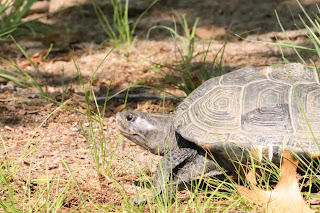A couple of years ago I was lucky enough to see baby Diamondback Terrapins be born. The lady in charge of protecting them even let me hold one and get photos before releasing them. Since then, I have wanted to see an adult up close. I had seen one at Brigantine NWR a couple years ago but it was in the scope and also it was all muddy.
Before I go any further, I can not divulge where I saw them. The place is not publicized to protect the turtles. Unfortunately, douche bags will collect them for pets or to sell them. It is a sad reality of our world. However, this post can still be educational and I learned a lot today. So here are some facts about Diamondback Terrapins.
- Terrapins are a brackish water species. They are not true sea turtles and they are not pond turtles. They live in areas where rivers meet the sea diluting the salt level.
- The females come up to lay their eggs at high tide and much more often during the day than night.
- The female only takes twenty minutes to dig a nest and deposit the eggs. Though she could take forty five minutes picking a suitable spot which is usually, but not always in sand.
- Males almost never come to shore. Though Terrapins will occasionally sun themselves it is not really part of their routine
- I can personally tell you that once finished covering the nest it is almost impossible to see it. They do a great job of camouflaging the eggs.
- The female will dig a hole. Then deposit a layer of eggs. Cover them, lay more eggs. Cover the second layer and lay a third layer. The hole is roughly eight inches deep.
- The eggs are about the size of a golf ball
- Terrapins will use their front flippers to throw sand on their back. It is believed this is to cover the glare so overhead predators can't see them as easily.
- As you would expect, they use their back flippers to dig a hole.
- When they are born their back (shell) is very bumpy with ridges on it. As they get older the shell gets smoother. A very old Terrapin will have a completely smooth shell.
- The people that protect the Terrapins pick them up when they are done laying. They measure the under part. If it is a turtle they have never seen they put a microchip in it and saw notches into the shell to identify it later. I watched this and it does not hurt the turtles.. They stayed still during the process.
- If people get too close to a female before she lays her eggs she will turn around and go back to the water and not lay her eggs. It is extremely important for people to keep their distance.
- Baby Terrapins do not make a beeline to the shore the way you've seen sea turtles do it in nature shows. They actually live on land for the first year before going into the bays and harbors. They live off of their yolk sac for a while, though I do not know how long.
- Data has been collected on 670 individual females at this location. Assuming there are an equal number of males, the population is well over one thousand.
- Last year 1700 babies were released into the wild but as we know, only a small percentage will survive to adulthood.
I had thought Terrapins, like sea turtles I've seen on Nat Geo, deposited eggs at night. I got a fairly early start this morning in the hopes of seeing one of the stragglers make its way back to the water. I was told they are more likely to come ashore during the day and when the tide is high. Well, I fell right into it because high tide was roughly 8:30 am. Sure enough Terrapins came ashore. Many places are roped off to protect them including trails leading to the water. The "guards" sit in chairs in the shade and wait for the turtles to nest. When done depositing eggs the people pick them up and the science begins. When they are measured and cataloged they are then released. They just head back to the ocean.
I got to see about ten Terrapins lay eggs today. I could tell the project leader wasn't very thrilled to have a visitor but she did let me stay. I sat with a kid, Alex, (about 22) that was in charge of one of the fields. We hit it off because he just got into striper fishing. So we talked about stripers the whole time until the first turtle made it to the sand pit.
We watched it from a distance until she was done. Then when it was done covering the nest, Alex picked it up and brought it to be measured. She was a young turtle and her first time laying. After the first terrapin the flood gates opened and in the next hour I saw all the turtles. After watching ten I decided to leave. I had gotten some decent photos and had a great experience. Obviously, more photos below. For better or worse, none of the photos have been edited.








No comments:
Post a Comment